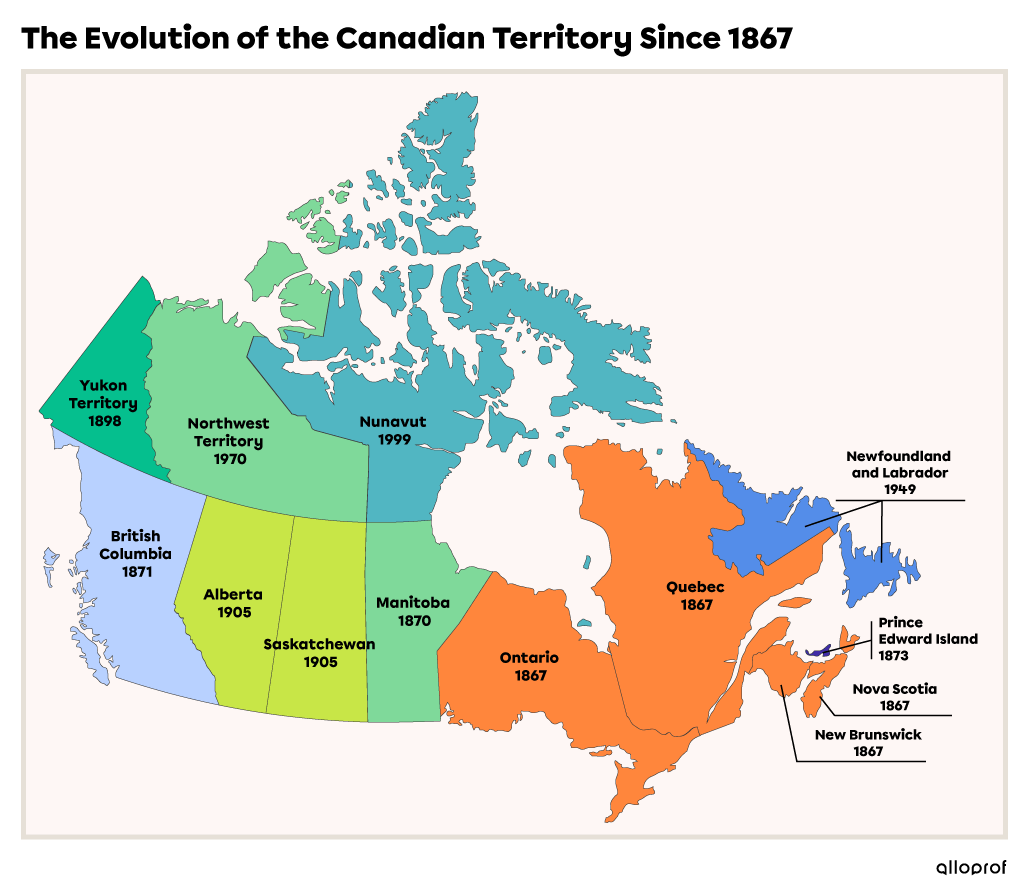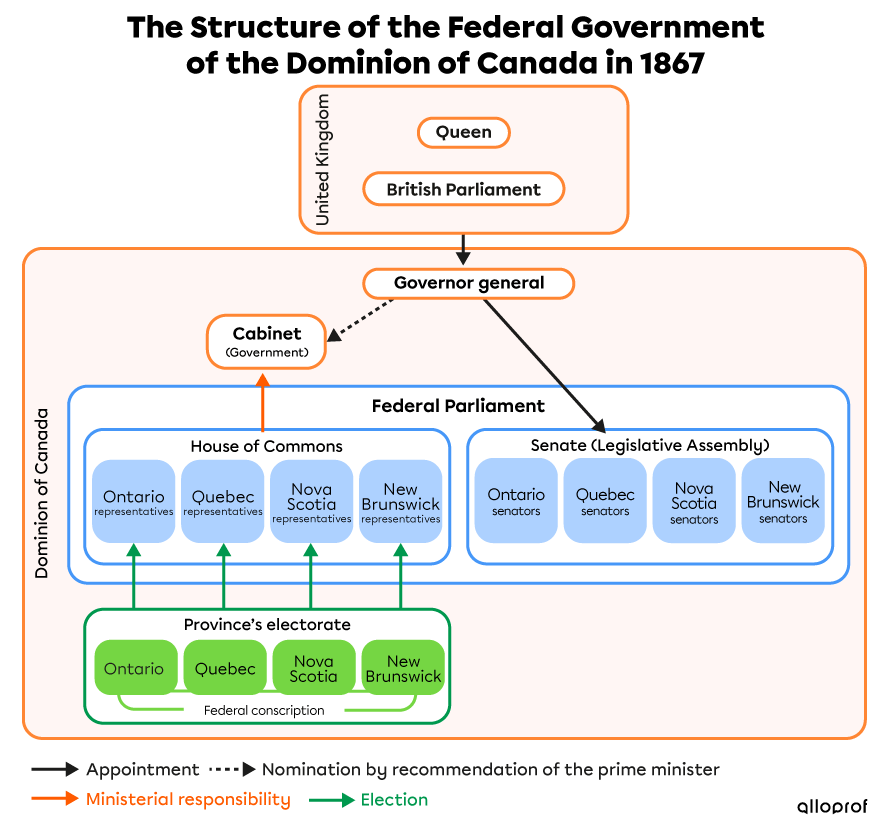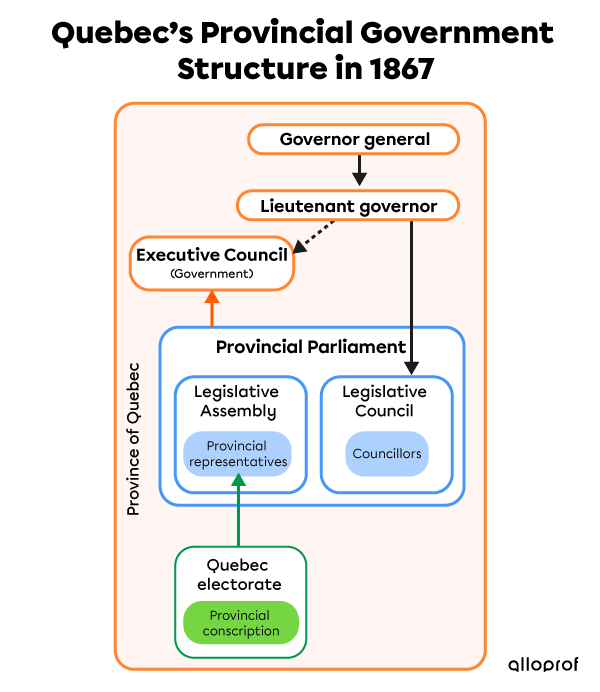In the late 1800s, Canada was facing several problems. To start, United Canada wanted greater independence from the British Crown. From an economic standpoint, the end of the Reciprocity Treaty with the USA significantly weakened the colony’s economy. Canada also suffered from serious ministerial instability, which complicated decision-making. Establishing a federation was viewed as a solution to the various problems, because this structure would create economic and political cohesion between the different colonies.
When the conferences in Charlottetown, Quebec City and London were over, the federation was formed and officially entered into force on July 1, 1867. However, during the signing of the Constitution, called the British North America Act (BNA Act), some of the colonies that had taken part in the discussions were hesitant about the idea of forming a federation. Consequently, the first provinces to form the Dominion of Canada were Quebec, Ontario, New Brunswick and Nova Scotia.
-
A dominion was a former British colony that obtained greater independence.
-
A federation is a union of several states (called provinces in Canada) under a central federal government.
When the Canadian Federation was initially created, it included four provinces, namely Quebec, Ontario, Nova Scotia and New Brunswick. Over the years, other provinces and territories joined too.

At first, the Canadian Federation included only Ontario, Quebec, New Brunswick and Nova Scotia. The other provinces joined the federation later.
At this time, the Dominion of Canada was managed by a Governor General (who represented the British Parliament) and a federal government. Each of the former colonies also had a provincial premier.

Legislative Branch
The legislative branch was administered by the Parliament. This parliament was composed of two bodies, the House of Commons, composed of representatives elected by the people, and the Senate, composed of senators appointed by the governor general. The purpose of the legislative branch was to draft and adopt laws.
Executive Branch
The executive branch was administered by the government. The government included the Cabinet, made up of the prime minister and ministers. The ministers were named by the Governor based on the prime minister’s recommendation. The prime minister selected the ministers from the representatives elected in the House of Commons, then the governor general approved the prime minister’s choices. The role of the executive branch was to implement the laws adopted by the legislative branch.
If you want to find out more about the role of the three branches of government, watch the video What Are the Differences Between the Legislative, Executive and Judicial Branches?

The image shows the political structure of the province of Quebec; this structure was the same for the other provinces (Ontario, Nova Scotia and New Brunswick).
Legislative Branch
Just like at the federal level, the provincial Legislative Branch was administered by the Parliament, but the names of the bodies were different. This Parliament included two bodies: the Legislative Assembly, composed of representatives elected by the people, and the Legislative Council, composed of councillors appointed by the governor general. The purpose of the Legislative Branch was to draft and adopt laws.
Executive Branch
Like its federal counterpart, the provincial Executive Branch was administered by the government. The government included the Executive Council composed of the premier and ministers. The ministers were appointed by the lieutenant governor on the premier’s recommendation. The premier selected the ministers from the representatives elected to the Legislative Assembly, then the lieutenant governor approved the premier’s choices. The role of the Executive Branch was to implement the laws created by the Legislative Branch.
The provincial and federal governments each have their own areas of responsibility.
| Areas of federal responsibility | Areas of provincial responsibility |
|---|---|
| Trade Taxes Currency Banks Indigenous peoples’ affairs Criminal law The militia Defence Residual powers (those not belonging to the provinces) |
Public lands and forests Healthcare Municipalities Marriages Ownership Civil law Education Commercial licences The provincial constitution |
The two levels of government also shared some areas of responsibility. For example, agriculture, economic development, prisons and justice, fishing, public works, transportation, communication and immigration fell under both federal and provincial responsibility.
Despite the fact that each level of government had its own areas of jurisdiction, the federal government had the power or right of disallowance over provincial laws.
The right of disallowance is a power held by the federal government allowing it to cancel or amend any law proposed by the provinces.

Data source: Périodes, 2017.
The federal government received taxes and customs duties, so naturally it managed more money than the provinces did. As the provinces also needed money to be able to cover the expenses falling under their areas of responsibility, the federal government gave them grants. In addition to these grants, the provinces could count on revenue from issuing permits and licences (for owning a store, for example) as well as for exploiting natural resources in their territory.
Charette, J., Déry, C., Jean, G., Fortier, S. N. et Rousseau, L.-P. (2017). Périodes : histoire du Québec et du Canada. De 1840 à nos jours — 4e secondaire [Manuel de l’élève]. CEC.